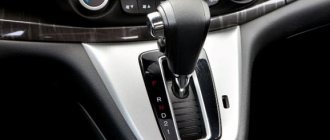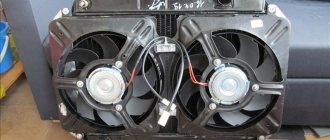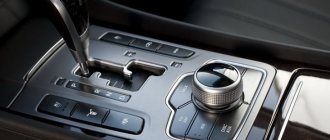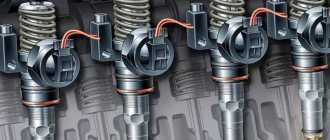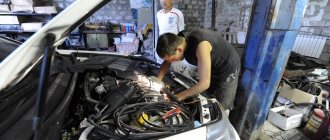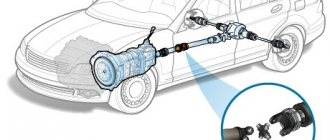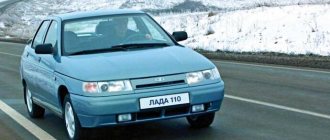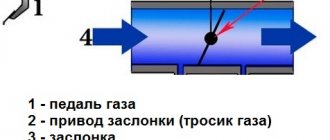The advent of automatic transmission was a huge step forward in improving driving comfort. But the first prototypes of such boxes were imperfect, so designers are constantly working to improve their performance characteristics, while at the same time taking care of reducing fuel consumption.
Currently, the most popular is a four-speed automatic transmission, since it has a limited number of operating modes, which makes it much easier for beginners to master the skills of handling this unit.
However, the presence of additional modes to the basic ones is not something exceptional - almost all simple automatic transmissions are equipped with non-standard modes used in appropriate situations. The Overdrive mode can hardly be called standard, but it is not exotic either, since it is present on so many boxes.
Let's consider why it is needed and in what cases it is used.
Overdrive Functions
To understand what Overdrive mode means, you need to understand what tasks the designers set when creating it. It's no secret that an automatic transmission has a much more complex design than its mechanical counterpart. Therefore, in general, the reliability of such a transmission is initially lower, even purely theoretically. This means that the developers are faced with the important task of reducing the operational loads on this unit. One way to solve this problem is to add gentle operating modes, allowing you to increase the overall resource of both the transmission and the power unit. Overdrive mode is just such a tool.
Its main purpose is to select the most optimal mode of movement, taking into account the current speed of the vehicle and the magnitude of the crankshaft torque. Enabling the mode can significantly reduce the load on the mechanical components of the transmission, which theoretically should also reduce fuel consumption.
A typical automatic transmission is equipped with four stages, with the third speed considered direct, since its gear ratio is equal to one. In a manual transmission, its analogue can be called fourth gear.
If the automatic transmission has an Overdrive mode, then there is also a fourth speed, indicated by O/D symbols. In a manual transmission, its analogue is fifth gear with a gear ratio less than one. This means that this gear is an overdrive, that is, the transmission output shaft rotates at a speed exceeding the crankshaft speed.
On cars equipped with a manual transmission, the optimal mode for engaging an overdrive gear is to achieve speeds of about 80-90-100 km/h. At the same time, fuel savings are achieved by increasing the output torque. In an automatic transmission, the driver has virtually no influence on the gear shifting process, which is why the O/D button appeared, which allows you to use the upshift mode.
The button itself has two location options:
- directly on the selector;
- separately on the panel or steering column (quite rare).
When the mode is enabled, the automatic transmission will switch to 4th gear when the car reaches high speeds, or when the driver slightly presses the accelerator pedal. As soon as the high gear is engaged, the torque converter will lock.
But since the automatic transmission is operated in completely different modes than the manual one, in reality, switching to fourth occurs at much lower speeds, about 50 km/h.
In this regard, many car owners have a question about how advisable it would be to use the Overdrive button on an automatic transmission when driving primarily in urban conditions. Let's try to understand this issue.
Why do you need overdrive?
O/D off icon on the dashboard. Informs that overdrive mode is turned off.
Based on the experience of car owners, many of them prefer to use overdrive both in a densely populated city, when the engine runs at a jagged pace, either slowing down or accelerating again, and on highways with a permitted maximum speed of up to 120 km/h.
Some drivers, however, have different opinions regarding the usefulness of overdrive mode for a car. Some people believe that turning it on saves fuel and reduces wear on the engine piston rings. For some, a significant argument “for” is the very addition of this function to the car by car company engineers.
But there are also opposing opinions, which say that from personal experience they checked the fuel consumption with and without the overdrive mode turned on, and did not notice a significant difference. As for the lower consumption of engine life, we cannot talk about frugality here, since with periodic decelerations and accelerations, the load on the engine only increases. In addition, in overdrive mode when driving around the city, the gearbox begins to work much more actively, which also affects its service life.
In most cases, suitable situations to use the overdrive function are:
- Driving on a high-speed highway (when the use of 4th gear is justified by the established speed limit);
- Overtaking at speeds up to 100 km/h (the value depends on the power of your engine);
- Uniform movement in the urban environment (in the absence of traffic jams and congestion).
Overdrive in the city
Should you use a higher gear when traveling within the city? The opinions of experts here are divided, and the arguments of both sides sound quite convincing and reasonable, so you will have to make a decision on your own.
Proponents of turning off this mode explain their position as follows: road conditions in modern cities are such that it is impossible to move at a uniform and relatively high speed for any length of time. This is hampered by dense traffic and the presence of adjustable traffic lights, which greatly influence the speed limit on certain sections of the road. This means that the box has to constantly switch, and when the mode is on, this will lead to frequent locking of the torque converter. And this means accelerated wear of this unit and an increase in fuel consumption that occurs out of the blue.
Adherents of using Overdrive believe that the last argument of their opponents is untenable. The point is that, regardless of whether the O/D button is turned on or off, the automatic transmission will still have to use frequent gear changes. And in this case, fuel consumption will certainly increase compared to driving on the highway, regardless of the time of year and the preferred driving style of the car owner. Therefore, even a short-term upshift will help save fuel.
When to turn on overdrive
According to experts, this function should be activated in the following cases:
- when accelerating quickly, when the vehicle is traveling faster than 100 kilometers per hour;
- when driving on uneven roads or off-road;
- driving on the highway;
- movement at constant speed;
- high speed;
- when a car is pulling a heavy trailer.
It is also worth turning on overdrive when driving in the city. This will significantly reduce fuel consumption.
How does the automatic transmission work when 4th gear is engaged?
If the display indicates that Overdrive is turned on, the car will sequentially switch from the first to the fourth stage when accelerating. But once overdrive is reached, the torque converter will be locked up. This moment is clearly noticeable thanks to a slight push - it is by this that most drivers determine the moment the car switches to an overdrive.
Strictly speaking, this is not an entirely correct judgment, since the cause of the push is not the transition to Overdrive, however, at high speed, locking of the torque converter can be caused by this very reason. Unlocking of the GT occurs when the car is braking, along with the automatic transmission switching to lower gears.
Overdrive mode and fuel consumption
During our introduction to the operating principle of Overdrive, we stated that its use saves fuel. As practice shows, this effect is rather demonstrative in nature, indicating that less fuel is actually consumed.
That is, the driver, with proper use of the mode, which involves turning it on/off in a timely manner, can save a little, but you should not count on a significant reduction. So any myths about the influence of Overdrive on fuel consumption should be taken with a considerable amount of skepticism. There are savings, but they are insignificant.
Overdrive mode on an automatic transmission, what are the features of use
They are determined by the following points: A sign of problematic situations with the overdrive mode is a flickering indicator signal on the console. It may indicate the presence of the following troubles:
- Shifting of one of the gears is faulty;
- Failures in the on-board computer.
- Solenoid failure;
- Wiring problems;
The most common problem is an open circuit in the switching circuit.
Therefore, you should conduct a visual inspection and try to find the location of the wire break. Also check the voltage at the connecting terminals.
If problems occur in your computer, you should roll back the software or order flashing from specialists. Photo: ad-cd.net Sometimes the problem is fixed by replacing the overdrive switch.
Over Drive
The automatic transmission has many operating modes, you can read about it here.
BUT “OD” or Over Drive, frankly speaking, is not a standard operating mode. As a rule, it exists on 4-speed automatic transmissions, but it is also available on some 6-speed versions. When turned on, the car switches to 4th gear at a speed of 50 - 60 km/h (unless, of course, you press on the gas).
What does this give? Of course, fuel economy and more gentle engine operation, because the speed is not high.
Many people drive with the mode on, many don’t, let’s think about the pros and cons of OVER DRIVE. 2) The engine resource increases due to low speeds 3) If you turn it off, a yellow lamp lights up on the panel, as if signaling a malfunction. This means that this mode needs to be enabled.
1) As the manufacturers assure, this function must be turned off in difficult conditions for the car. But the city has difficult conditions!
2) When the mode is turned on, the machine makes more shifts, and accordingly the resource decreases 3) When OVER DRIVE is turned on, the car slows down worse with the engine. I'll finish. I hope my article helped you.
Pros and cons of Overdrive mode
Although overdrive in automatic transmissions appeared relatively long ago, passions about this issue still rage to this day. Some consider it a useful acquisition, others are against using Overdrive. Let's try to sort everything out and start by listing the advantages of having this mode:
- the overdrive mode allows for smoother operation of the power unit at low speeds;
- when driving for a long time in the speed range of 60-100 km/h, you can save a considerable amount of gasoline;
- the automatic transmission, and with it the engine, wear out to a lesser extent;
- During long trips, the Overdrive mode provides increased comfort for the driver.
But there are also many disadvantages:
- a large number of automatic transmission models do not have an O/D shutdown button, so the overdrive will always be engaged, even when driving at high speed does not last long;
- if the car is used primarily within the boundaries of a large populated area, Overdrive will be an almost useless option;
- frequent switching on/off of the 4th stage of the automatic transmission leads to an increase in the number of torque converter shutdowns, which can hardly be called a positive thing;
- When the Overdrive mode is turned on, it becomes more difficult to control the car in difficult road conditions (for example, icy conditions) - engine braking becomes extremely difficult.
From the above we can conclude that the use of ML is not always good. Fortunately, this transmission mode is not standard, so the driver can decide when to use it and when not to use it. In any case, its absence reduces the functionality of the automatic transmission.
But even without it, to be completely honest, you will lose very little.
Using the OD mode of an automatic transmission in practice
To understand how to use the overdrive mode in the city, let's look at a specific example. The car can move uphill in traffic, constantly changing speed from 30 to 70 km/h.
If overdrive mode is turned on, the automatic transmission will shift to all gears (1,2,3,4). Also after accelerating to 40-50 km. The torque converter will be blocked if the driver does not press the gas pedal very hard.
Let's imagine that the car accelerates to 60 km/h, while 4th gear is engaged and the engine speed is low. If at a certain moment you need to accelerate, you should not expect a sharp response to pressing the gas pedal, since fourth gear is engaged, and there are not enough revolutions for intensive pickup in this gear.
All you have to do is press the gas harder, the kick-down will work, a sharp downshift will occur and acceleration will begin. Further, this situation is repeated many times. Naturally, in this case, comfort is significantly reduced, and the gearbox itself wears out faster and more intensely when constantly changing gears.
If you turn off overdrive, under load the car will move in a maximum of 3rd gear, and it reacts more responsively to pressing the gas pedal, the engine speed is higher, and without shifting down there is enough traction for acceleration.
However, you should not assume that disabling 4th gear will lead to an increase in fuel consumption. The fact is that the forced use of the kick-down mode if O/D is turned on ultimately leads to greater fuel consumption during city use.
It turns out that you need to be able to use the overdrive mode, turning it on and off depending on certain conditions. As mentioned above, it is better to turn off overdrive:
- if active driving is practiced at low speeds;
- on long descents/ascents;
- if the pace of movement is constantly changing;
- for comfortable movement at speeds up to 50 km/h;
- when towing a trailer/carrying cargo in a car;
- during prolonged overtaking at medium speed;
By the way, regarding the last point, you need to remember that turning off overdrive will cause the engine speed to increase sharply, and the increase can be right up to the cutoff.
You also have to turn on/off the O/D mode with a separate button, and it is extremely unsafe to be distracted from the road at speed and, especially, while overtaking. For this reason, when overtaking on the track, it is optimal to use kick-down rather than overdrive.
The only exception is safe overtaking of relatively slow-moving vehicles. In this case, the overdrive is turned off in advance, only then does overtaking begin; if necessary, kick-down is also activated in parallel with the overdrive turned off.
Finally, we note that regardless of the type of transmission and the available modes of its operation, the main thing is to be able to correctly predict the situation, take into account road conditions, and the operating features of the automatic transmission on a particular car model. Only after making sure of complete safety can you overtake, change lanes and other maneuvers.
Overdrive analogue
Drivers with minimal experience should not use Overdrive - their experience is clearly not enough to understand in which cases the button should be pressed and when this should not be done. For beginners, any road situation is difficult, so decisions need to be made quickly; any delay is fraught with trouble. Including those related to the inclusion of ML mode. So you should rely more on the automation controlled by the on-board computer than on your own little skills.
The same applies to the Kick Down mode, which is a kind of antagonist to Overdrive. Although it is common for beginners to believe that these are related modes. In fact, this mode has no analogues, and you need to use it skillfully.
When to turn off overdrive
This should be done in the following cases:
- driving at a speed of 35-65 kilometers per hour;
- being in a traffic jam;
- ascent or slow descent;
- different pace of movement, frequent stops;
- slow motion.
To summarize, I would like to note that overdrive mode is an excellent tool for every driver. The main thing is to understand how to use it. In general, this is a great way to reduce fuel consumption, as well as wear and tear on the car's engine and its individual components.
